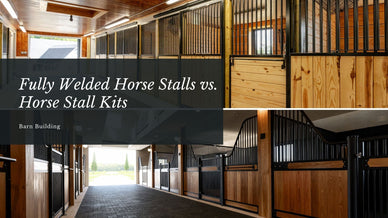A Guide to Function, Safety, and Beauty in Every Detail
Your horse’s stall door is far more than a way to open and close a stall — it’s one of the most important elements in your barn’s daily rhythm. The right stall door design influences safety, airflow, efficiency, and aesthetics. It’s the gateway to your horse’s comfort and your peace of mind.
At American Stalls, we’ve spent over 15 years crafting and refining stall doors that balance form and function, built to stand the test of time, thousands of daily uses, and the natural wear of barn life. Here’s what every equestrian should consider when designing their perfect stall doors.
Swinging Doors or Sliding Doors?
When planning your barn, one of the first design choices you’ll face is between Sliding or Hinged (European) Stall Doors.
Both have their merits, but we typically recommend Sliding Stall Doors for new builds and remodels. They offer unmatched efficiency and safety, especially in busy barns where time and space are precious. Sliding Doors allow for quick access and eliminate the clearance space that hinged doors require. In an emergency, they can be opened swiftly and secured in place, making them a safer and more practical choice. Hinged doors, while traditional and charming, can become hazards if left open in an aisleway.
Sliding Doors allow for quick access and eliminate the clearance space that hinged doors require. In an emergency, they can be opened swiftly and secured in place, making them a safer and more practical choice. Hinged doors, while traditional and charming, can become hazards if left open in an aisleway.
Our recommendation: Go with sliding stall doors for a streamlined, secure barn flow, or read this article to discover more pros and cons.
Steel or Wood?
Classic wooden stall doors have a certain nostalgic beauty, but modern barns require durability. We recommend steel-framed Stall Doors for strength and longevity.
Steel construction ensures that your doors remain structurally sound for years, resisting warping, damage, and wear. Still, if you love the warmth of wood, we can easily integrate tongue-and-groove lumber into the steel frame to bring that timeless charm to your design.
For more insights on choosing entryways that elevate your barn’s design and functionality, explore our guide Barn Building 101: Barn End Doors and Dutch Doors, a closer look at how thoughtful door design enhances ventilation, natural light, and overall barn comfort.
Best of both worlds: A steel frame for integrity, with wood inserts for texture and tradition.
Bars, Mesh, or Full Wood Inserts?
Design isn’t just about looks; it’s about your horse’s health and safety. We always prioritize airflow, visibility, and security when designing Stall Doors.
Our favorite combinations feature vertical steel bars on top for ventilation and sightlines, paired with steel mesh on the bottom for strength. Vertical bars allow light and communication between horses, while mesh prevents hooves from catching and adds durability.
When evaluating stall doors, look for:
- 1” round bars placed on 3” centers to prevent injury.
- Vertical, not horizontal, bars — the safest option for any horse.
A stall door can be all bars, all mesh, or a mix of both, the right balance depends on your horses and the aesthetic of your barn.
Centered or Off-Centered Door Placement?
While off-centered doors can work in specific barn layouts, we’ve found that centered stall doors offer the best functionality.
A centered door design makes it easier to position feed and water systems on either side, keeping stall interiors well-organized.  For handling safety, we recommend that the door slide to the left. This allows the handler to keep the horse in the right hand and operate the door with the left, a small but meaningful design consideration that enhances everyday safety.
For handling safety, we recommend that the door slide to the left. This allows the handler to keep the horse in the right hand and operate the door with the left, a small but meaningful design consideration that enhances everyday safety. The result: a barn that flows as beautifully as it looks.
The result: a barn that flows as beautifully as it looks.
Yoke or No Yoke?
The “yoke”, the graceful opening at the top of the stall door, is one of the most beloved design features in modern barns. It invites connection. Horses can extend their heads into the aisle, socialize, and stay curious about their surroundings.
Yokes not only enhance airflow and interaction, but they also add an elegant architectural touch. We especially recommend yoke openings when the partitions are solid, full-wood panels.
However, yokes aren’t ideal for every barn. They require wide aisleways (at least 14 feet) for safety and may not suit every horse’s temperament.
Our rule of thumb: If your horse enjoys interaction and your barn layout allows, a yoke door adds both beauty and personality to the space.
To explore different styles that balance beauty and functionality, visit our article 4 Types of Yokes in Horse Stall Doors, where we break down open, hinged, and removable yoke designs to help you create a comfortable and social environment for your horses.
Lastly, a stall door is one of the most-used components in your barn, and one of the most expressive. When thoughtfully designed, it becomes part of the story your barn tells every day: a story of craftsmanship, safety, and care for the horses you love.
Whether you envision a traditional look or a sleek, contemporary feel, the key is balance, between elegance and practicality, heritage and innovation.
At American Stalls, every door we build reflects this harmony. Because when you open a stall door thousands of times over the years, it should feel just as solid and beautiful as the first.
Do you have more questions regarding your existing stall doors or a new stall project? Contact us today, and our team would be happy to assist with any questions and project planning.





